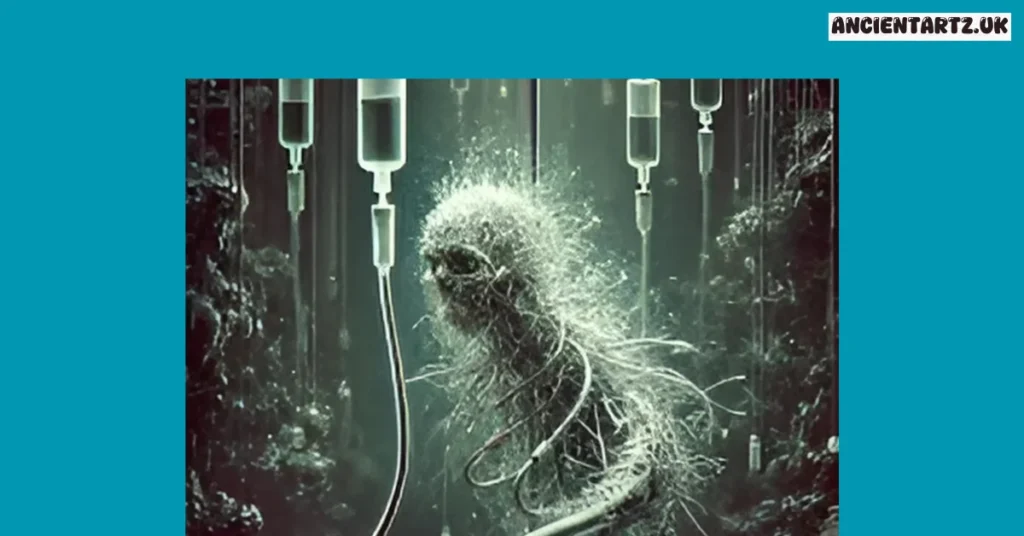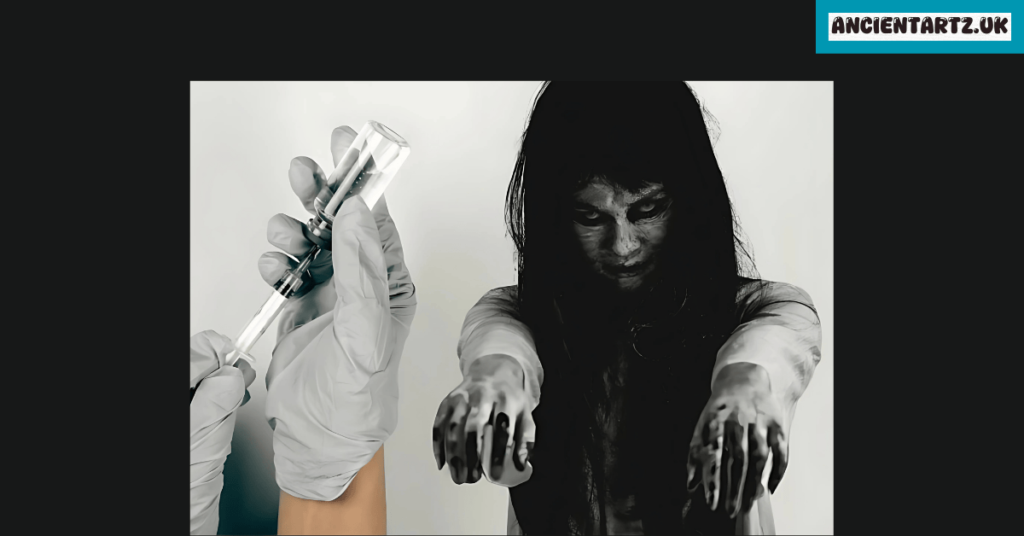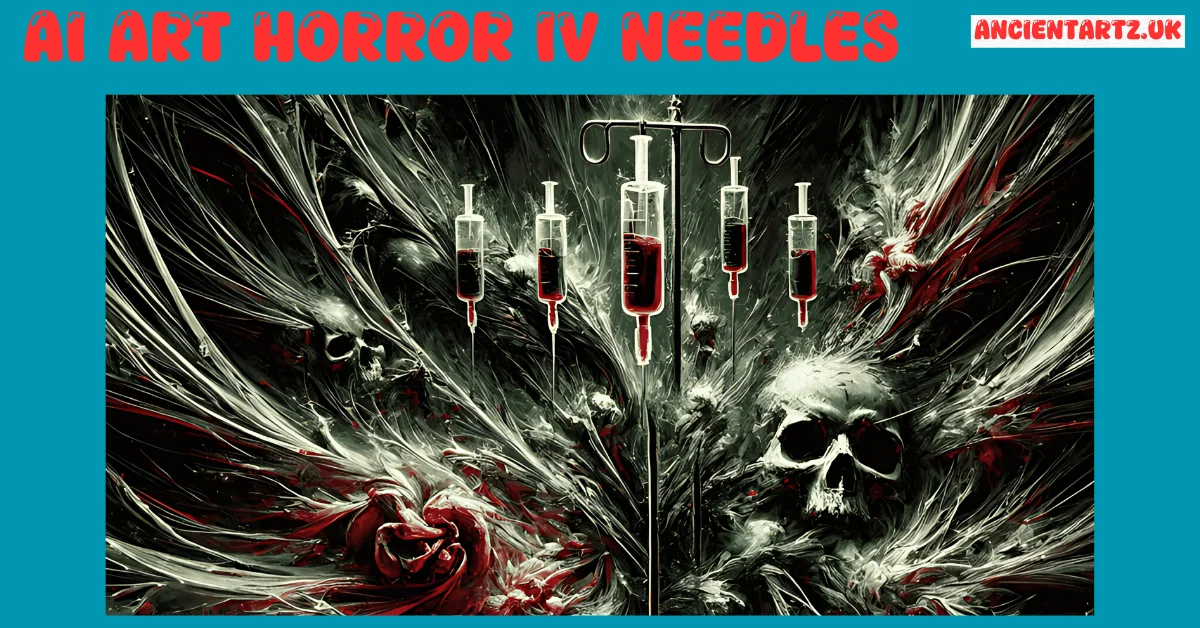The rise of AI-generated art has brought both creativity and eerie new themes to the forefront. One of the most unsettling areas is AI art horror IV needles, where artificial intelligence creates horrifying images involving IV needles in chilling, medical-themed settings. This specific type of AI horror art taps into deep fears about vulnerability, pain, and medical procedures. In this article, we’ll dive into why AI art horror IV needles is so disturbing and why it fascinates so many people.
The Appeal of AI Art Horror IV Needles

Horror has always been about exploring fears that disturb us the most, and medical themes often play a key role. IV needles are a common source of discomfort for many people because they represent physical pain and the feeling of losing control over your body. When AI is used to create horror art with IV needles, the result is often unsettling and highly realistic.AI-generated horror art featuring IV needles tends to amplify the anxiety that comes with medical interventions. The sharp, metallic look of the needles combined with ominous settings, like dark hospitals or dystopian clinics, heightens the fear factor.
How AI Creates Chilling IV Needle Imagery
AI uses sophisticated algorithms to produce highly detailed and realistic art. One of the most common techniques used in AI art horror IV needles is Generative Adversarial Networks (GANs). GANs consist of two neural networks that work together: one creates images, and the other evaluates them. This continuous process allows the AI to generate more accurate and often scarier visuals over time.In the context of IV needles, AI might create images of patients hooked up to drips filled with mysterious liquids or needles inserted into skin in unnatural, grotesque ways. This adds an eerie and surreal touch that often leaves viewers feeling unsettled.
Read More: mario de graaf art
Themes in AI Art Horror IV Needles
- Medical Horror: AI-generated horror involving IV needles often taps into fears about hospitals and invasive medical procedures. These images might feature patients connected to IVs in grim, sterile environments, with the medical equipment looking more threatening than healing.
- Body Horror: One of the most common themes in AI art horror IV needles is body horror, where AI distorts the human body. In these images, IV needles are exaggerated, showing them unnaturally large or piercing through the body in terrifying ways.
- The Uncanny Valley Effect: The uncanny valley refers to how we feel uneasy when something looks almost, but not quite, human. AI-generated horror art often plays with this, creating lifelike human forms attached to IVs, but with slight distortions that make the image feel eerie and unnatural.
Why IV Needles Are So Unsettling
The imagery of IV needles in horror is especially powerful because it directly connects to common fears about pain, health, and vulnerability. For many, IV needles represent being in a powerless situation, such as being in a hospital, and having no control over what’s happening to their body.When these images are generated by AI, the precision and detail make the fear even more intense. AI’s ability to create hyper-realistic visuals means the needles can look unnervingly real, which taps into deep-rooted anxieties many people have about medical environments.
The Allure of AI Horror Art: Disturbing Imagery of IV Needles
AI-generated horror art, particularly featuring IV needles, taps into deep-seated fears associated with medical procedures, vulnerability, and invasiveness. This unsettling combination evokes a pervasive discomfort, making IV needles a compelling subject in the realm of horror art.
The Psychological Impact of IV Needles
IV needles elicit a primal sense of fear due to their clinical coldness and potential for harm. Their representation in horror art plays on our innate anxieties surrounding health and medical interventions, transforming a common medical instrument into a powerful symbol of dread.
The Role of AI in Crafting Terrifying Imagery
AI has revolutionized the creation of horror art by merging advanced algorithms with artistic vision. By analyzing patterns in unsettling environments, AI can produce unique and bizarre visuals that traditional techniques might struggle to achieve. This capability enables artists to explore new dimensions of fear, pushing the boundaries of creativity and horror.
Ethical Considerations of AI Art Horror IV Needles
As AI art horror IV needles becomes more popular, ethical concerns are being raised. Medical imagery, especially when exaggerated for horror, can trigger strong emotional reactions or even trauma in some viewers. The hyper-realism that AI offers may make these images too intense for certain audiences, which raises the question of whether creators should put limits on how disturbing their content can be.There is also the concern that AI-generated horror could desensitize people to disturbing content. As the technology improves, the line between reality and fiction could blur, potentially leading to negative psychological effects on viewers.
AI-Generated Horror: Creativity Without Human Limitations

AI-generated horror art leverages deep learning algorithms and neural networks, processing thousands of images, concepts, and artistic styles to create something both familiar and alien. In this process, AI learns to mimic human creativity and can push the boundaries beyond what a human mind might typically conceive. While traditional horror art relies heavily on human emotion and experience, AI art is unbounded by these limitations. It doesn’t have an innate sense of fear or revulsion; instead, it learns from patterns and associations, creating images based on how it “understands” fear through human input.
The Future of AI-Generated Horror Art
As AI technology continues to evolve, so too will its ability to create horror art that pushes the boundaries of our imaginations. The depiction of IV needles in this art form is just one example of how AI can tap into deep-seated fears and anxieties, transforming everyday objects into powerful symbols of horror. The combination of medical imagery with technological distortion is likely to remain a potent theme, particularly as we continue to grapple with our own relationships with technology and healthcare.
FAQs about AI art horror IV needles
FAQ 1: What is AI art horror IV needles?
Answer: AI art horror IV needles refers to unsettling digital artwork created by artificial intelligence that features IV needles in disturbing medical settings. This genre explores fears related to pain, vulnerability, and medical procedures.
FAQ 2: Why do IV needles evoke fear in horror art?
Answer: IV needles symbolize vulnerability and loss of control in medical situations. Their depiction in horror art amplifies anxieties about pain and invasive procedures, creating an unsettling visual experience.
FAQ 3: How does AI generate horror art involving IV needles?
Answer: AI uses techniques like Generative Adversarial Networks (GANs) to create detailed and realistic images. These algorithms generate visuals by combining patterns from existing images, resulting in unique and often disturbing art.
FAQ 4: What themes are prevalent in AI art horror IV needles?
Answer: Common themes include medical horror, body horror, and the uncanny valley effect, which explores distorted human forms that feel unsettlingly close to reality but are slightly off.
FAQ 5: Are there ethical concerns surrounding AI-generated horror art?
Answer: Yes, ethical concerns include the potential for triggering trauma in viewers and the risk of desensitization to disturbing imagery. Creators are encouraged to consider the emotional impact of their work on audiences.
Ending Word’s
AI art horror IV needles taps into deep-seated fears surrounding vulnerability, pain, and medical interventions. By leveraging advanced algorithms, artists can create unsettling and hyper-realistic imagery that challenges our perceptions of horror. While this genre fascinates many, it also raises ethical considerations about the psychological impact of such art. As technology continues to evolve, the exploration of fear through AI-generated horror is likely to grow, pushing the boundaries of creativity and our understanding of discomfort.
Read next: dave chappelle net worth
